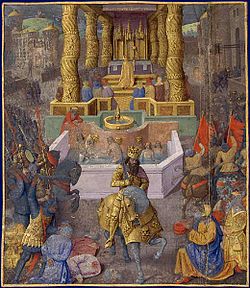Kingdom of the Jews Regnum Iudaeorum ממלכת היהודים | |||||||||
|---|---|---|---|---|---|---|---|---|---|
| 37–4 BCE | |||||||||
 Herodian kingdom of Judea at its greatest extent | |||||||||
| Status | Client state of the Roman Republic / Roman Empire | ||||||||
| Capital | Jerusalem | ||||||||
| Common languages | Koine Greek, Aramaic, Latin, Hebrew, Phoenician, Old Arabic | ||||||||
| Religion | Second Temple Judaism Samaritanism Paganism Ancient Semitic religion Canaanite religion North Arabian polytheism Hellenistic religion Roman imperial cult | ||||||||
| Government | Monarchy | ||||||||
| King of the Jews | |||||||||
• 37 BCE – 4 BCE | Herod the Great | ||||||||
| Historical era | Roman Palestine | ||||||||
• conquest of Hasmonean kingdom | 37 | ||||||||
• formation of Tetrarchy | 4 BCE | ||||||||
| Currency | Herodian coinage | ||||||||
| |||||||||
| Today part of | |||||||||
| History of Israel |
|---|
 |
The Herodian kingdom [1] [2] was a client state of the Roman Republic, later Roman Empire, ruled from 37 to 4 BCE by Herod the Great, who was appointed "King of the Jews" by the Roman Senate. [3] When Herod died, the kingdom was divided among his sons into the Herodian tetrarchy.
Contents
- Background
- Roman involvement in the Levant
- Parthian invasion and Roman intervention
- Herod as king
- Fate of the Hasmonean dynasty under Herod
- Dissolution: formation of the Tetrarchies
- See also
- References
The Herodian kingdom included the regions of Judea, Samaria, Idumaea, and Galilee, as well as several regions east of the Jordan River—Perea, Batanaea, Auranitis, and Trachonitis. [4] [5]

